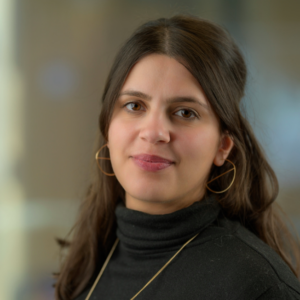Four minute read:

Dr Basak Tas was awarded the SSA’s first post-doctoral transitional development support in 2019, finishing in March 2020. We caught up with Dr Tas to find out more about the scheme and about her ongoing research.
“There are not many schemes out there for the time between a PhD and a fellowship or a more stable job.”
SSA: What made you first consider the SSA post-doc transitional funding?
Dr Basak Tas: “So, I was looking for some way of developing the work that I’ve been doing as part of my PhD and exploring other lines of research. I was interested in a fellowship but didn’t think I was experienced enough for a full fellowship application. I saw the transitional scheme on the SSA website and remember trying to find out if anyone had applied before that I could talk to, and I didn’t think I knew anyone that had; so, I was trying to make a guess about whether I could apply for it or not.”
“It just seemed to make sense because I was looking for a fellowship, I wanted that time period of 12 months. I don’t know what you call it, a transitional, or bridging, or whatever it is between a PhD and post-doc or the next step in academia.”
Did you have a specific idea of what you wanted to do? Or did you use this funding to allow you to explore more options?
“Yeah, I had some ideas but definitely needed some time to explore more options and to build a longer-term project which is what I have been able to do. I have been able to think about, and widen, my research and gather data that I need to build a bigger project. Some of the work involved re-starting or continuing my PhD work where there were certain things that needed changing to make it more robust. But I also got to build upon that work and start some other, related, but slightly separate lines of research which I think is really interesting and which I think has a future.”
What was the application process like? What kind of information did you need to get to apply for this fellowship?
“The application process was pretty straightforward actually. There were a few online pages with questions but there was essentially a short description of what you plan to do in the time. And that was the key aspect of it. And yes, it was a quite straight-forward application, which was good because you want to know whether you get it as soon as possible so you can get started.”
“I also needed to arrange joint funding from my university. There were 12 months, with half the time funded by the SSA and half the time funded by my department. Which I think is not too onerous a financial burden and it gives people like me enough time to think about where they need to go next and to explore ideas.”
“The future aim would be to have something that could detect or predict an imminent risk of harm, such as overdose, but also to intervene if necessary.”
With your ongoing research, what has this fellowship allowed you to do?
“Well, I was doing some work in my PhD about measuring overdose and respiratory depression among long-term heroin users and there were certain things that I was able to tweak and then re-start. I also got to explore a few other avenues. As part of the overdose studies I use a lot of physiological measures and these are heavy and bulky. To widen the study to more participants I basically found more portable ways of measuring what we want to measure. And this is great because we can now travel to wherever participants are. And that is what I am starting to embark on now (COVID-permitting).”
“So, another avenue that I’m slowly pushing forward with involves working with different industry partners and technology companies to fine tune how we can use wearable devices and sensors within the overdose studies. The future aim would be to have something that could detect or predict an imminent risk of harm, such as overdose, but also to intervene if necessary. And that’s a really big task where we’re really just at the first steps of right now.”
“A related thread is where I’ve been able to collaborate with colleagues (some at King’ College London, some external) who work in biomechanics or AI. They look in detail at movement either by using these really cool bits of kit that allow you to visualise whatever movement of wherever in the body you want to look at or by using simple devices that can be programmed with clever algorithms. The idea is to look at whether we can predict or detect imminent injection as part of a series of events that may lead to an abnormal turn of events. Again, this is just the initial stepping-stones in putting together the idea. We’ve got the technology and ability to look at movement and behaviour and we can use this ability to minimise harm or to intervene in an appropriate way. But there’s still a lot more work to be done, these are still the very first steps.”
“There are other sensors in development that need approvals and things like that and potentially in the future there will be more sensors”
The opinions expressed in this post reflect the views of the author(s) and do not necessarily represent the opinions or official positions of the SSA.
The SSA does not endorse or guarantee the accuracy of the information in external sources or links and accepts no responsibility or liability for any consequences arising from the use of such information.

